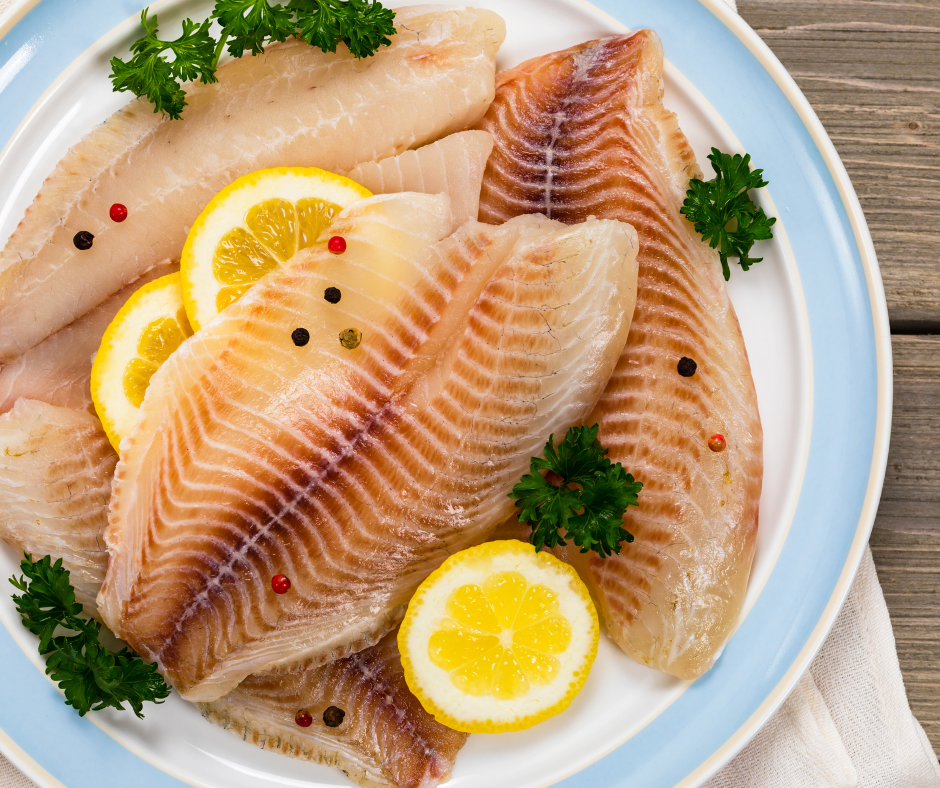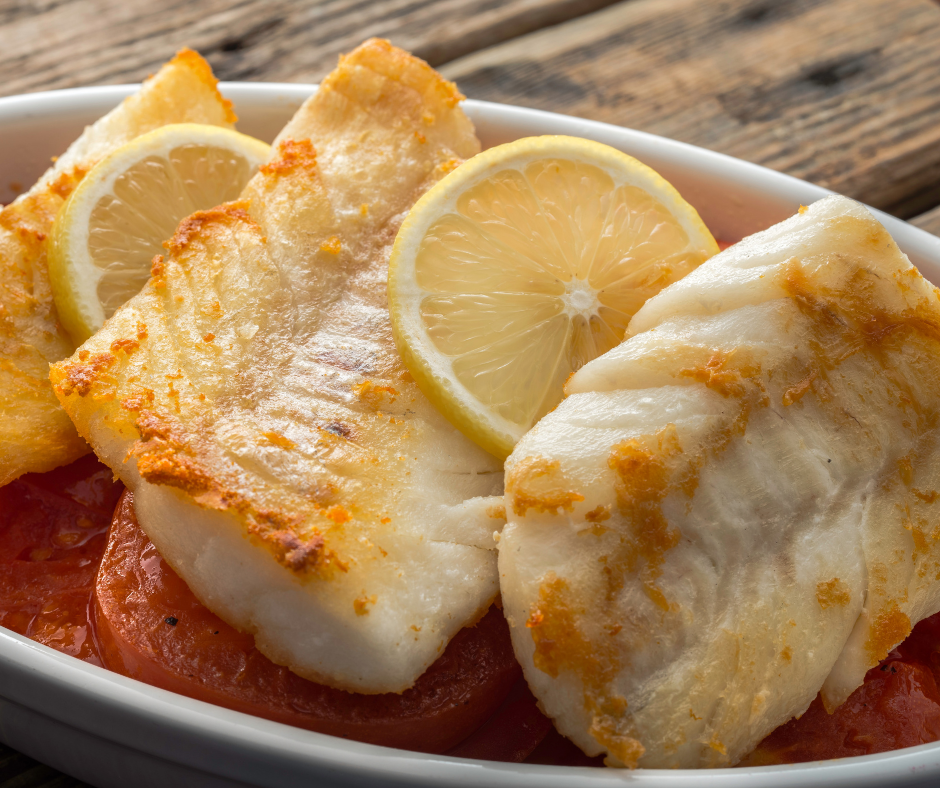Introduction
Two popular options for white fish that come to mind are cod and tilapia. While both offer unique culinary experiences, they differ in taste and texture. This blog post will provide an overview of Cod vs Tilapia Taste, the importance of taste when selecting fish, and the contrasting flavors of these two popular white fish varieties.
Overview Of Cod And Tilapia
Cod is widely consumed in North America and is known for its mild flavor and white flesh. It is a versatile fish that can be prepared in various ways, including pan-frying, baking, and grilling. Cod has a more robust taste that pairs well with stronger seasonings. It also has a firmer and meatier texture compared to tilapia.
Tilapia, on the other hand, has gained popularity for its milder taste and firmer texture. It boasts a slightly sweet flavor, making it a favorite choice for those who prefer a more delicate profile. Like cod, tilapia is versatile in the kitchen and can be cooked differently.
Importance Of Taste In Selecting Fish
Taste plays a crucial role when selecting fish for any culinary preparation. Different fish varieties’ flavors can greatly impact a dish’s overall taste. Hence, understanding the taste profiles of cod and tilapia can help you make an informed decision when choosing the right fish for your recipe.
The taste of fish is influenced by various factors, including the species and the environment in which it is raised or caught. It’s important to note that farming practices can greatly impact the quality and sustainability of the fish, so it’s always a good idea to choose products certified by reputable organizations.
The difference when comparing Cod vs Tilapia Taste can be attributed to their distinct flavor profiles. Cod presents a more distinct and slightly stronger taste, making it ideal for dishes that require bolder flavors. On the other hand, tilapia offers a milder taste that is well-suited for those who prefer a subtler flavor in their dishes.
It’s worth mentioning that personal preferences and recipe requirements should also be considered when selecting fish based on taste. Different recipes call for different flavors, and understanding the taste profiles of cod and tilapia can help you make the best choice to achieve the desired outcome.
In conclusion, cod and tilapia are two popular white fish varieties that offer distinct taste experiences. Cod has a mild yet robust flavor, while tilapia boasts a milder and slightly sweet taste. Understanding the importance of taste and the unique flavors of these fish can help you select the most suitable option for your culinary creations.

Cod Flavor Profile
Regarding the taste of cod, a few key characteristics make it a beloved choice among seafood enthusiasts. Understanding these flavor profiles can help you create delicious dishes that highlight the best aspects of this popular white fish.
Characteristics Of Cod’s Flavor
Cod has a mild yet distinctive flavor sets it apart from other white fish varieties. It is often described as having a slightly sweet taste, with a hint of saltiness that enhances its overall profile. This makes cod a versatile ingredient paired with various seasonings and ingredients.
The texture of cod is another notable characteristic. It has a firm and meaty texture that holds up well during cooking. When cooked, cod flakes apart into larger, chunkier pieces, making it ideal for dishes like fish and chips or fish tacos.
Factors Affecting Cod’s Taste
Several factors can influence the taste of cod, including its sourcing, cooking methods, and seasoning choices.
- Sourcing: The environment in which cod is raised or caught can impact its flavor. Cod from cold waters, such as Atlantic cod, tends to have a sweeter and more recognizable flavor. On the other hand, cod sourced from warmer waters might have a slightly milder taste.
- Cooking Methods: How cod is prepared and cooked can also affect flavor. For example, baking or grilling cod can enhance its natural flavors, while frying or deep-frying can add a crispy texture and different taste dimensions.
- Seasonings and Pairings: Cod’s mild flavor makes it a great canvas for various seasonings and sauces. Stronger seasonings like lemon, garlic, herbs, and spices can bring out the natural flavors of cod and add depth to the overall taste experience. It also pairs well with tomatoes, olives, capers, and buttery sauces.
In conclusion, cod offers a mild yet distinct flavor profile, making it a versatile and popular choice among seafood lovers. Its slightly sweet taste, firm texture, and ability to pair well with various seasonings and ingredients make cod a go-to option for many culinary creations. Understanding the characteristics and factors that influence cod’s taste can help you create flavorful and satisfying dishes that showcase the best of this delicious white fish.
Tilapia Flavor Profile
Regarding the taste of tilapia, distinct characteristics differentiate it from cod and make it a popular choice for seafood enthusiasts. Understanding the flavor profile of tilapia can help you appreciate its unique qualities and incorporate it into your culinary creations.
Characteristics Of Tilapia’s Flavor
Tilapia has a milder taste compared to cod, often described as neutral or earthy. It lacks the pronounced sweetness of cod but still offers a pleasant flavor well-suited for various dishes. The mildness of tilapia makes it a versatile fish that can be prepared in various ways and easily paired with different seasonings.
Apart from its taste, tilapia has a firm white flesh that holds up well during cooking. This makes it suitable for dishes that require a sturdy texture, such as grilling or baking. When cooked, tilapia maintains its structure and doesn’t flake apart as easily as cod, making it an excellent choice for recipes that call for a firmer fish.
Factors Affecting Tilapia’s Taste
Just like cod, several factors can influence the taste of tilapia. These factors include sourcing, cooking methods, and seasonings.
- Sourcing: The environment in which tilapia is raised can impact its flavor. Tilapia sourced from different regions may have slight variations in taste. For example, tilapia from freshwater sources might have a cleaner and milder flavor than those raised in saltwater environments.
- Cooking Methods: How tilapia is prepared and cooked can greatly affect its taste. Grilling or broiling tilapia can enhance its natural flavors and bring out a slightly smoky or charred taste. Pan-frying or sautéing can add a crispy texture and bring out the fish’s natural sweetness.
- Seasonings and Pairings: Tilapia’s mild flavor makes it a blank canvas for many seasonings and sauces. It pairs well with both delicate and bold flavors. Lemon, garlic, herbs, and spices can all be used to enhance the taste of tilapia. Additionally, tilapia complements citrus fruits, tropical salsas, and light buttery sauces.
In summary, tilapia offers a milder and more neutral flavor than cod. Its mild taste and firm texture make it a versatile fish that can be enjoyed in various dishes. Sourcing, cooking methods, and seasonings can influence Tilapia’s taste, allowing you to tailor its flavor to your preferences. Whether you prefer cod’s slightly sweet taste or tilapia’s milder profile, both fish offer unique culinary experiences for seafood lovers.

Cod vs Tilapia Taste
When choosing between cod and tilapia, taste plays a crucial role. Let’s explore the differences in texture, mouthfeel, and flavor notes to help you make an informed decision.
Texture And Mouthfeel
Cod is known for its mild, flaky white flesh and firm texture. The firmness of cod makes it easy to handle and cook while also providing a satisfying mouthfeel. When cooked, cod retains its structure and doesn’t easily flake apart, making it suitable for dishes that call for firmer fish.
On the other hand, tilapia has a more delicate texture that is often described as tender. Its firm white flesh holds up well during cooking but has a softer mouthfeel than cod. Tilapia’s tenderness makes it a versatile ingredient that can be used in various dishes, allowing for a more melt-in-your-mouth experience.
Flavor Notes And Preferences
Cod has a slightly sweet taste, which pairs well with tartar sauce and other condiments. Its mild flavor profile allows it to absorb and complement the flavors of different seasonings, making it a popular choice in cuisines like British, Scandinavian, and Portuguese.
Tilapia, on the other hand, has a milder taste compared to cod. It is often described as neutral or earthy, lacking the pronounced sweetness of cod. However, this mildness makes tilapia a versatile fish that can be prepared in various ways. Its neutral flavor allows it to be easily paired with different seasonings, herbs, and spices, making it a blank canvas for culinary experimentation.
Regarding personal preferences, some individuals may favor the slightly sweet taste of cod, while others may prefer the milder and neutral profile of tilapia. It ultimately depends on your taste buds and the specific flavors you enjoy.
In summary, Cod vs Tilapia Taste offers contrasting experiences. Cod has a slightly sweet taste and a firm texture, while tilapia has a milder flavor and a more tender texture. Both fish can be prepared in various ways, allowing for different culinary creations. Whether you prefer the firmness and sweetness of cod or the delicate tenderness of tilapia, both fish have unique qualities that can satisfy seafood enthusiasts.
Factors Influencing Cod And Tilapia Taste
Diet And Environment
Their diet and environment can influence the taste of cod and tilapia. Cod feeds on diverse marine life, especially Atlantic cod, contributing to its slightly sweet and recognizable flavor. On the other hand, tilapia’s diet consists mainly of algae and lake plants, resulting in a milder taste that some may even describe as flavorless. However, high-quality farmed tilapia fed a well-balanced diet can taste better than wild-caught tilapia.
Processing And Cooking Techniques
How cod and tilapia are processed and cooked can also affect their taste. Cod is often praised for its firm, flaky white flesh, which holds well during cooking. This makes it suitable for dishes that require a fish with a firmer texture. The firmness of cod also allows it to retain its structure even when seasoned or sauced, resulting in a delightful mouthfeel.
On the other hand, tilapia has a more delicate texture that becomes tender when cooked. Its white flesh easily falls apart into smaller flakes, making it perfect for dishes where a softer, melt-in-your-mouth experience is desired. Tilapia’s tenderness allows it to absorb flavors and spices, making it a versatile ingredient that can be prepared in various ways.
Culinary Preferences
Personal preferences play a significant role in the flavors of cod and tilapia. Some individuals may prefer the slightly sweet taste of cod, which pairs well with tartar sauce and other condiments. Cod’s mild flavor makes it an excellent canvas for absorbing and complementing the flavors of different seasonings, making it popular in various cuisines.
On the other hand, tilapia’s milder and neutral taste allows it to be easily paired with different seasonings, herbs, and spices. Its versatility makes it a flexible option for culinary experimentation, as it can take on a wide range of flavors without overpowering them. Whether you prefer the delicately sweet taste of cod or the blank canvas of tilapia, both fish offer unique qualities that satisfy different palates.
In summary, the taste of cod and tilapia can be influenced by various factors. Cod’s slightly sweet flavor and firm texture make it a popular choice for those looking for a satisfying mouthfeel, while tilapia’s milder taste and delicate texture provide a more tender and versatile culinary experience. Ultimately, the choice between cod and tilapia comes down to personal preference and the specific flavors that individuals enjoy.

Conclusion
When it comes to the comparison of Cod vs Tilapia Taste, distinct differences can influence your culinary choices. Cod offers a more robust and slightly stronger flavor than tilapia’s milder, sweet taste. The texture of the two fish also varies, with cod having a firmer and meatier consistency, while tilapia has a more delicate profile that easily falls apart when cooked. Both fish have unique qualities that suit different dishes and flavor preferences.
Summarizing The Contrasting Flavors Of Cod And Tilapia
Cod and tilapia, two popular white fish, offer contrasting flavors that cater to different palates. While cod presents a more distinct and slightly stronger taste, tilapia boasts a milder, slightly sweet flavor. Cod’s firm and meatier texture holds up well to stronger seasonings, making it suitable for dishes that require a bolder taste. On the other hand, tilapia’s delicate profile lends itself well to more delicate and melt-in-your-mouth cooking experiences.
Considerations For Choosing The Right White Fish
When deciding between cod and tilapia, there are a few considerations. One factor to consider is your preferred specific flavors, as cod offers a slightly sweeter taste. At the same time, tilapia provides a blank canvas that can absorb different seasonings and spices easily. The firmness of cod also makes it suitable for various cooking methods, such as pan-frying, baking, and grilling, while tilapia’s tenderness lends itself well to softer preparations.
It’s also important to consider your nutritional requirements. Cod is higher in Omega-3 fatty acids, contributing to heart health and reduced inflammation. However, both fish are considered heart-healthy options due to their omega-3 content.
Lastly, sourcing and sustainability are important factors to consider. Choose products certified by reputable organizations to ensure responsible farming practices that minimize environmental and ethical issues. This ensures that your choice of fish aligns with your values and supports sustainable seafood practices.
In conclusion, the taste of cod and tilapia varies significantly, offering different experiences for different culinary needs. Whether you prefer the robust taste and firm texture of cod or the milder, delicate profile of tilapia, both fish satisfy diverse palates. Consider your preferences, desired flavor profiles, cooking methods, nutritional requirements, and sustainability considerations when choosing the right white fish for your next culinary adventure.
FAQ about Cod vs Tilapia Taste: Contrasting the Flavors of Two Popular White Fish
Q: Is the taste of cod strong?
A: No, the taste of cod is not very strong. It tends to have a sweeter and more recognizable flavor, especially the Atlantic cod.
Q: How would you describe the taste of tilapia?
A: Tilapia is very mild, with some describing it as flavorless. It has a sweetness similar to a red snapper or striped bass. It tastes less fishy than cod and other fish.
Q: Which fish is firmer when cooked, cod or tilapia?
A: Tilapia is firmer than cod when cooked. Its meat falls apart into smaller flakes, while cod has a slightly softer texture.
Q: Is tilapia fishy tasting?
A: As a freshwater fish, tilapia is not overwhelmingly fishy tasting. It is mild and slightly sweet, making it suitable for recipes where other flavors can take center stage.
Q: Can tilapia be substituted for cod in recipes?
A: Tilapia can be substituted for cod in various dishes, such as fish and chips or fish tacos. It has a slightly sweeter and firmer texture.
Q: Which fish is more sustainably sourced, cod or tilapia?
A: Tilapia is more sustainably sourced than cod. Since it is a freshwater fish, it can be farmed in various habitats and feeds on plant-based food.
Q: How do the nutritional profiles of cod and tilapia compare?
A: Cod is considered healthier than tilapia because it is leaner and contains more Omega-3 fatty acids. It also has higher amounts of other nutrients like niacin, B vitamins, and choline.
Q: When you compare Cod vs Tilapia Taste, do they have similar taste and texture?
A: Both fish have a similar taste but differ in texture. Tilapia has a flakier texture, while cod is not as flaky. Cod is slightly sweeter compared to tilapia.
Q: Are there any recommended recipes for cooking cod?
A: Cod can be cooked in various ways. One great recipe to try is a cod fillet recipe, which highlights the fish’s tenderness and slightly sweet flavor.
Remember to consult professional sources and consider personal preferences when making dietary choices.

